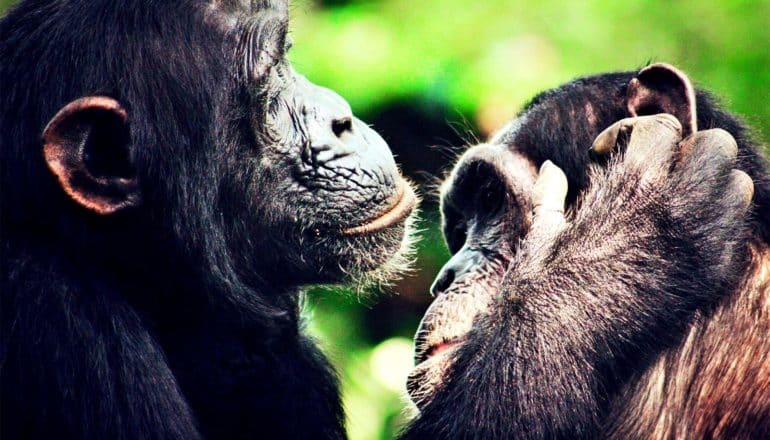
A new study on chimpanzee communication supports one of the most promising theories for the evolution of human speech.
The evolution of speech is one of the longest-standing puzzles of evolution. Inklings of a possible solution started emerging some years ago, however, when researchers showed monkey signals involving a quick succession of mouth open-close cycles exhibited the same pace of human spoken language.
“This dispels much of the scientific enigma that language evolution has represented so far.”
In the new paper in Biology Letters, researchers found that the rhythm of chimpanzee lip smacks also exhibit a speech-like signature—a critical step towards a possible solution to the puzzle of speech evolution.
Just like each and every language in the world, monkey lip smacks have previously shown a rhythm of about 5 cycles/second (i.e. 5Hz). This exact rhythm had been identified in other primate species, including gibbon song and orangutan consonant-like and vowel-like calls.
There was no evidence, however, from African apes, such as gorillas, bonobos, and chimpanzees—who are more closely related to humans, meaning the plausibility of this theory remained on hold.
Now, the researchers, using data from four chimpanzee populations, have confirmed that they too produce mouth signals at a speech-like rhythm.
The findings show there has been most likely a continuous path in the evolution of primate mouth signals with a 5Hz rhythm. Proving that evolution recycled primate mouth signals into the vocal system that one day was to become speech.
Scientists had never studied African great apes, the closest species to humans, for the rhythm of their communication signals. When the researchers investigated the rhythm of chimpanzee lip smacks, which they produce while they groom each other and found that chimpanzees produce lip smacks at an average speech-like rhythm of 4.15 Hz.
Researchers used data across two captive and two wild populations, using video recordings collected at Edinburgh Zoo and Leipzig Zoo, and recordings of wild communities including the Kanyawara and the Waibira community, both in Uganda.
“Our results prove that spoken language was pulled together within our ancestral lineage using ‘ingredients’ that were already available and in use by other primates and hominids,” says Adriano Lameira of the psychology department at the University of Warwick. “This dispels much of the scientific enigma that language evolution has represented so far. We can also be reassured that our ignorance has been partly a consequence of our huge underestimation of the vocal and cognitive capacities of our great ape cousins.”
“We found pronounced differences in rhythm between chimpanzee populations, suggesting that these are not the automatic and stereotypical signals so often attributed to our ape cousins. Instead, just like in humans, we should start seriously considering that individual differences, social conventions, and environmental factors may play a role in how chimpanzees engage ‘in conversation’ with one another,” he explains.
“If we continue searching, new clues will certainly unveil themselves. Now it’s a matter of mastering the political and societal power to preserve these precious populations in the wild and continue enabling scientists to look further,” Lameira says.
Additional researchers from St Andrews University, the University of York, and the University of Warwick contributed to the work.
Source: University of Warwick
The post Chimp lip smacks hint at human speech evolution appeared first on Futurity.
from Futurity https://ift.tt/2AhTLDH
No comments:
Post a Comment